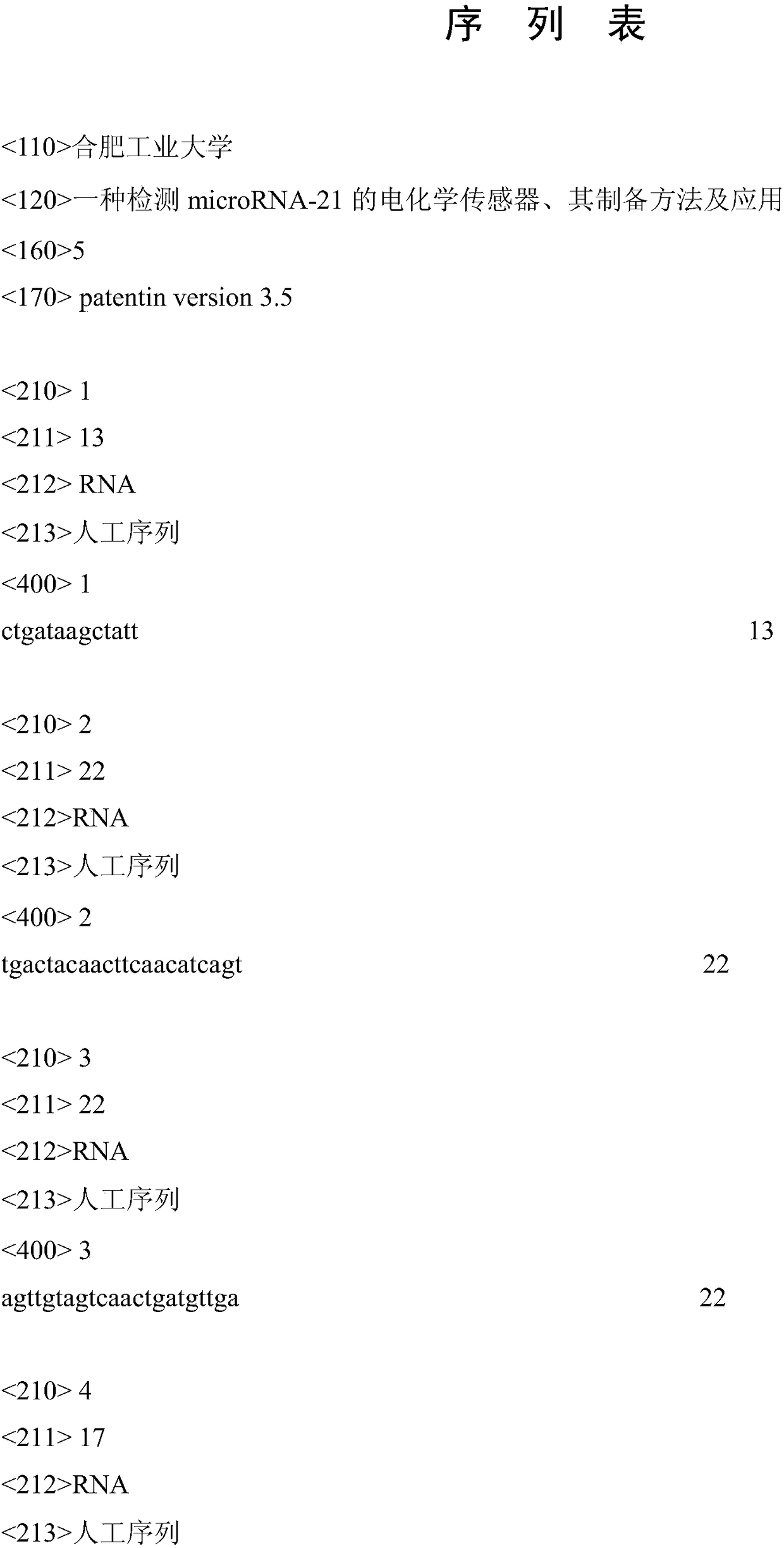Electrochemical sensor for detecting microRNA-21, preparation method and application thereof
An electrochemical and sensor technology, applied in the fields of life and health and medical analysis, can solve the problems of low expression, poor specificity, time-consuming, etc., and achieve the effect of good detection sensitivity and excellent specificity
- Summary
- Abstract
- Description
- Claims
- Application Information
AI Technical Summary
Problems solved by technology
Method used
Image
Examples
preparation example Construction
[0025] One aspect of the embodiments of the present invention provides a method for preparing an electrochemical sensor for detecting microRNA-21, the electrochemical sensor includes a working electrode, a reference electrode and a counter electrode, and the preparation method includes:
[0026] contacting the activated capture probe with a gold electrode as a working electrode and incubating, and then applying mercaptohexanol to the gold electrode and incubating to block the blank site;
[0027] Constructing DNA concatemers by hybridization chain reaction, and preparing G-quadruplex-rich lines by extending DNA with terminal deoxyribonucleotidyl transferase;
[0028] applying the DNA concatemer to the surface of the gold electrode for incubation, and interacting with the streptavidin solution;
[0029] A biotin-labeled G-quadruplex-rich line is applied on the surface of the gold electrode, the biotin can specifically recognize the streptavidin, and the G-quadruplex-rich line i...
Embodiment 1
[0056] (1) Preliminary preparation of the gold electrode: ① The gold electrode was polished and polished with 0.05 μm alumina slurry for 5 minutes, and then rinsed thoroughly with ultrapure water to remove the alumina powder non-specifically adsorbed on the surface of the gold electrode; The electrodes were soaked in the prepared piranha solution (H 2 SO 4 / H 2 o 2 , volume ratio 3:1) for 30 min, then thoroughly rinsed with ultrapure water and sonicated with ethanol and ultrapure water for 5 min to remove any remaining impurities; ③ in 0.5M H 2 Set the scanning potential to -0.2 and 1.5V in SO4 solution, and perform electrochemical scanning cleaning on the electrode at a scanning rate of 100mV / s until a stable voltammetric peak is obtained; Blow dry; ⑤ Add the pre-activated probe (at room temperature, incubate 2.5 μL 1 mMTCEP with 5 μL 1 μM capture probe CP for 30 min) dropwise on the treated Au working electrode, and incubate at 4 °C for 12 h; ⑥ Put 5μL of 1.0mM mercaptoh...
Embodiment 2
[0064] (1) Preliminary preparation of the gold electrode: ① The gold electrode was polished and polished with 0.05 μm alumina slurry for 5 minutes, and then rinsed thoroughly with ultrapure water to remove the alumina powder non-specifically adsorbed on the surface of the gold electrode; The electrodes were soaked in the prepared piranha solution (H 2 SO 4 / H 2 o 2 , volume ratio 3:1) for 30min, then thoroughly rinsed with ultrapure water and sonicated with ethanol and ultrapure water for 5min to remove any remaining impurities; ③ at 0.5MH 2 Set the scanning potential to -0.2 and 1.5V in SO4 solution, and perform electrochemical scanning cleaning on the electrode at a scanning rate of 100mV / s until a stable voltammetric peak is obtained; Blow dry; ⑤ Add the pre-activated probe (at room temperature, incubate 2.5 μL 1 mMTCEP with 5 μL 1 μM capture probe CP for 30 min) onto the treated Au working electrode, and incubate at 6 °C for 16 h; ⑥ Put 5μL of 1.0mM mercaptohexanol (MC...
PUM
 Login to View More
Login to View More Abstract
Description
Claims
Application Information
 Login to View More
Login to View More - R&D
- Intellectual Property
- Life Sciences
- Materials
- Tech Scout
- Unparalleled Data Quality
- Higher Quality Content
- 60% Fewer Hallucinations
Browse by: Latest US Patents, China's latest patents, Technical Efficacy Thesaurus, Application Domain, Technology Topic, Popular Technical Reports.
© 2025 PatSnap. All rights reserved.Legal|Privacy policy|Modern Slavery Act Transparency Statement|Sitemap|About US| Contact US: help@patsnap.com



